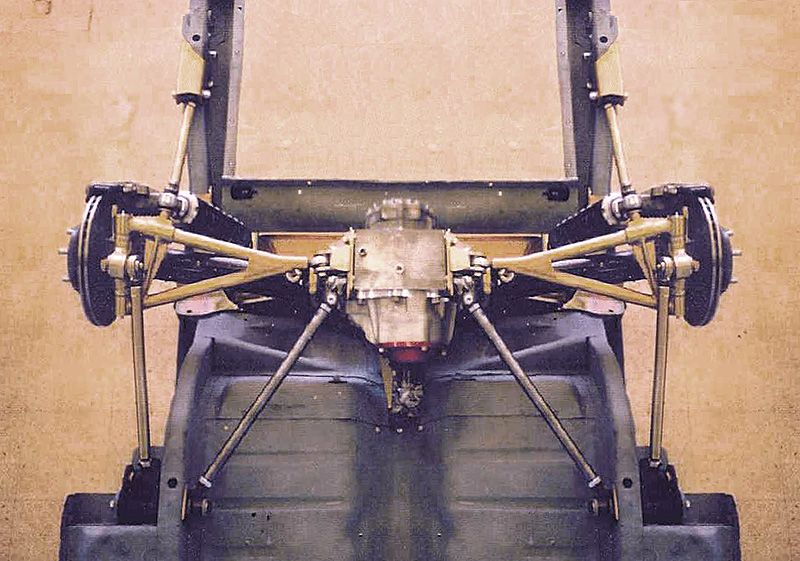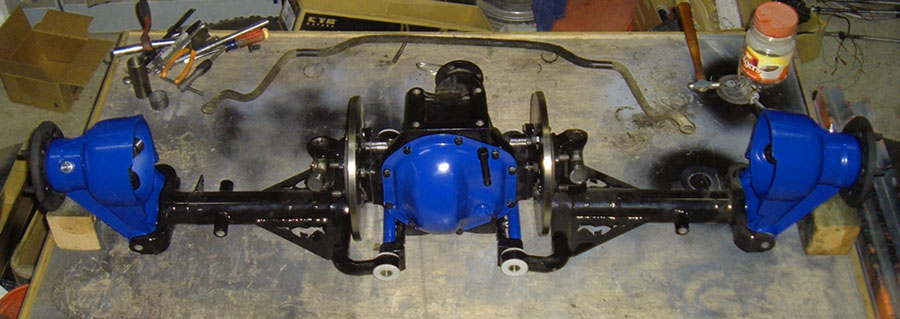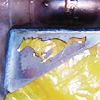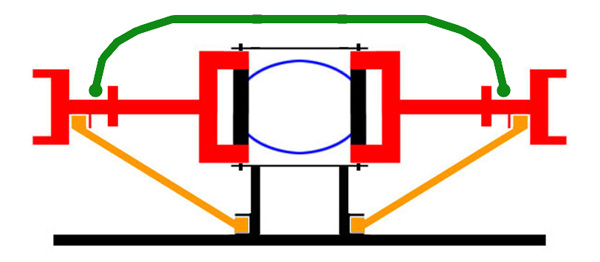

 |
 |
 |
 |
 |
You are not logged in. Would you like to login?
 1 of 1
1 of 1
![]() Offline
Offline

and when should be we trying to make them even better???? This is a question inspired by the comments Mustsed made in the thread Hey Ralphy, take a look at this IRS(we have seen it in several posts )
Mustsed wrote:
Before the IRS the Mustang was a blast to drive and it can only become better with IRS. There has to be an end sometime on the modification list I wrote 20 years ago ;-))))))
And that right there is the real issue, how much is to much and at what point do the effects of the "improvements" we are adding become negligible. I think Håkan said it perfectly in his email relating to my desire to make my anti-squat adjustable when he said:
Håkan from Sweden wrote:
To be really honest though I don't think you will have any noticeable difference at all with different anti squat settings unless it's completely off as you have it now. On a race car where they are hunting 10th of seconds on lap times on different tracks it might be motivated to have adjustable anti squat. I don't want to sound negative in anyway, but I remember back in the eighties when I asked a very knowledgeable guy about how to make design adjustments to a front end geometry to avoid anti dive, he just answered: "Are you going to race at Le Mans?" and when I said "No!" he just said "Ok, just forget about it!"
how far is to far??? It has been proven by the many people who have already put an IRS in their cars that bolting up something like a Jag IRS (or any other IRS for that matter) with out any consideration for rear steer, anti-squat, or other suspension characteristics (basically just bolting the IRS in) is an upgrade to handling and drivability over their OEM live axles. So where do we draw the line??? I love the fact that a forum like this is a place to combine the mental power of its members and think about all the possibilities. The danger lies in over thinking. It is easy to look at all these wonderful ideas and say "I want that" It is much harder to look at all the ideas and decide exactly what we NEED. We are all modifying are cars to make them better, and so it is easy for us to be tempted by all the "upgrades" available to us, but at what point do we have enough improvement?? What do you think about the following modifications?
1. Top of the hub watts link
2. Watts link in place of trailing arms
3. Linear anti-squat adjustments. In other words being able to set the suspension to have a consistent rearward travel through the full range of suspension motion.
4. Reactive anti-squat. In other words anti-squat that is initiated by hard acceleration or extreme suspension travel.
5. Rear steer created by slight toe adjustment due to extreme suspension movement
6. Tubular LCAs
7. Inboard disc brakes or outboard disc brakes?
8. LCA bearings or UHMW bushings
9. Rigidly mounted differential and or cage or a bushing mounted differential and or cage
those are all the ones I could think of but I am sure there are more, feel free to add any I have missed.
Last edited by Daze (11/03/2011 6:43 am)

![]() Offline
Offline

1. Top of the hub watts link
+1 This is one of those things I am in favor of. The single biggest downfall to IRS is IMHO wheel hop and upper watts link has been proven to help eliminate this so I am all for it.
2. Watts link in place of trailing arms
-1 A watts link trailing arm is straight up cool, but my opinion is a normal trailing arm is just as effective at stabilizing the LCA and is a whole lot easier to set up.
3. Linear anti-squat adjustments. In other words being able to set the suspension to have a consistent rearward travel through the full range of suspension motion.
=0 I honestly don't have a guess. this is one of those real world things I can test in my car. because the angle of my sub frame can adjusted I will probably experiment with several shackle lengths to see if it effects handling when accelerating out of a turn.
4. Reactive anti-squat. In other words anti-squat that is initiated by hard acceleration or extreme suspension travel.
-1 this to me is something for track cars more than street cars. It is not that I don't think it is a good idea I just think it will be much harder to create as a home built project and I am guessing the easier to achieve linear anti-squat will probably be effective enough.
5. Rear steer created by slight toe adjustment due to extreme suspension movement
=0 I am undecided on this one
6. Tubular LCAs
+1 I think they are lighter and less likely to twist than the Jag wishbone or other IRS stamped pieces AND with a tubular LCA things like toe and camber can be adjusted.
7. Inboard disc brakes or outboard disc brakes?
+1 -1 depends on the application. The real issue is unsprung weight or cool looking and easy to work on. I think it really depends on the application, and what a person really wants out of their IRS system
8. LCA bearings or UHMW bushings
+1 I don't think the UHMW bushings are as "good" as the bearings but I don't think the differences will be noticeable when driving and the reduction in replacement parts and cost makes it all worth wile.
9. Rigidly mounted differential and or cage or a bushing mounted differential and or cage
+1 -1 depends on what is more important to you ride quality or handling.

![]() Offline
Offline

OK, I read only a little. How much is to much? I totally agree, however! I keep talking ability to adjust for one. What if I miss the mark on my idea and I get some weird effect? Say this roll steer sucks! If I build my ideas hard set I can be screwed. That Cobra Arning setup is an example. Next, do I really need roll steer? I can quote a performance article that suggests not inducing roll steer. Anti/squat or dive again I can find articles saying it's not suggested. FIRST! You have to know what your intentions are what can you live with. Reel my experience back, I have the Corvette C3 rear set up factory. It does almost everything WRONG, toes out, no anti-squat, wheel base shortens and it's worn slap out. THE CAR STILL HANDLES PRETTY DAMN GOOD!
In short however what I do want, the ability to adjust first. Second as of right now I would like to remove the half shaft as a member.
OK, Anti- squat you say it's for track cars not the street. With anti-squat I think you get anti-dive on the rear. I consider the anti-dive more important then squat. Track cars, what track cars? Drag cars for sure but many track cars I think do not use anti-squat. Lowering your center of gravity is a great equalizer.
Last edited by Ralphy (11/03/2011 8:18 am)
![]() Offline
Offline
I have my Mustang since 1989 and most of the time it has been sitting in the garage and having updates done to it. Lot of these upgrades are removed because they didn' work out as well as tought!!!! Anyhow, the car is really a million decades away from the stock factory configuration and drives great. It should be enough but the government forces me to do my last two mods. The first is for the high gas prices over here = EFI and the second is for the mountain roads over here = IRS. I will stop doing anything besides regular maintenance to my '67 Mustang.
The reason why we do it is = because we can do it!! Spending hours in the garage or shop to improve something nobody except yourself will notice. That's why it has to have a end!! I love my car and have to son's waiting for me to pass it over to them. The last few years I am looking for a 4 door big Ford which will only get good brakes, good steering and some comfort items like A/C - that's it!
And now to your points;
1. Top of the hub watts link
**To much distance to the LCA hub pivot point, braking and accel might cause to much stress on LCA bushings.
2. Watts link in place of trailing arms
** That's what I'm doing or plan to do!
3. Linear anti-squat adjustments. In other words being able to set the suspension to have a consistent rearward travel through the full range of suspension motion.
** My car will have a hard short travel and I don't think that this will be a problem therefore ditch any mod according this.
4. Reactive anti-squat. In other words anti-squat that is initiated by hard acceleration or extreme suspension travel.
** Same as #3 answer.
5. Rear steer created by slight toe adjustment due to extreme suspension movement
** Don't thing that this will something I will considering to adjust.
6. Tubular LCAs
** Stock jaguar's are tubular .
7. Inboard disc brakes or outboard disc brakes?
** This is a missing visual expectation on open wheels therefore I did it on my setup. This car is setup for more unsprung wheight on the rear.
8. LCA bearings or UHMW bushings
** Have done the UHMW bushings because the stgock bearings didin't fit. Bearings might be better but they didn't fit my outboard disc hubs.
9. Rigidly mounted differential and or cage or a bushing mounted differential and or cage
** There should be the possibilty to remove the IRS easy of the car therefore I would like to have a bushed cage.
Mustsed
![]() Offline
Offline

Mustsed wrote:
8. LCA bearings or UHMW bushings
** Have done the UHMW bushings because the stgock bearings didin't fit. Bearings might be better but they didn't fit my outboard disc hubs.
I am needing to have some of these made do you have the specs you had them machined too?? I already have the specs for the older stile hub but need them for the newer hub.

![]() Offline
Offline

Ralphy wrote:
In short however what I do want, the ability to adjust first.
I agree the more adjustment you can build in the better chance you have of "getting it right" the only down side is making those adjustments as strong as solidly mounting something and then the other issue is getting it correctly dialed in. If you have to many adjustments you create a huge number of combinations and it might be hard to find the best one.

![]() Offline
Offline
Mail send Daze!
Mustsed
![]() Offline
Offline
I'm glad someone brought this topic up. I've been wondering myself about what aspects of setting up an IRS or even a complete suspension system that I should even concern myself with. There seems to be an endless list of terms out there that get thrown around, and I wonder just how much a lot of it matters in the end.
First off, I appreciate ingenuity. If someone wants to put in a lot of energy to try to get something perfect, then great. That describes me most of the time. But, this is a case where, by putting an IRS in a car that that didn't already have one to start with, I am already in the 95th percentile as far as level of ingenuity. That's pretty good. My time is precious, and my objective is to have a finished car to enjoy. I don't like endless tinkering.
I just want a car that rides and handles well. There are plenty of modern cars out there that fit that criteria with bolt-in suspension systems. That's what I am aiming for. I'd like to have a parts list of what I need, get the parts, put it together, bolt it in, and move onto the next phase.
![]() Offline
Offline

Day,
I think I changed sides or slid more toward the keep it simple side as far as anti-squat and roll steer. My thought today! LOL! Is these features are more leaned to the street performance group. So as far as my considerations, I have lowered the need for them.
Now you asked about the need for various ideas, such as watts links etc... Let me fire one back at you. Is not a double wishbone the design of choice for handling? Is not this the way manufactures are going? I have never seen a car with front suspension parts going for and aft and being touted as a better design than double wishbone.
With that said, you Jag guys have the basis to build such a beast with a little work. More so than I, have you seen it done?
Last edited by Ralphy (11/09/2011 4:14 pm)
![]() Offline
Offline

This guy refers to the 2/3rds ratio. My half shaft is 12" and my camber rod is 18". He's right on.
Last edited by Ralphy (11/09/2011 6:48 pm)
![]() Offline
Offline

Ralphy wrote:
Let me fire one back at you. Is not a double wishbone the design of choice for handling? Is not this the way manufactures are going? I have never seen a car with front suspension parts going for and aft and being touted as a better design than double wishbone.
With that said, you Jag guys have the basis to build such a beast with a little work. More so than I, have you seen it done?
The trade in my mind is simplicity for stability. The upper arm on a double wishbone has two functions, it first helps contribute to the camber curve and second it stabilizes the hub. In the case of the Jag unit the suspension is simpler by using the half shaft as the upper arm, In the Jag design it contributes to the camber curve but has no control on for and aft movement.
correct me if I am wrong but if you go with a Jag unit and then use an upper watts link you get the best of both worlds. you get simplicity, and ease to narrow up the suspension, you get a specific camber curve from the half shaft AND you get the upper hub stability from the watts link. in some ways the watts acts like an upper control arm, BUT it is even better. a normal control arm has to serve double duty from one point. there are forces going at it from several direction which can lead to deflection, but by using the half shaft and the watts in unison You have two different independent supports designed to specifically control things from one direction and by dividing it out each one is better at what it does.
Ralphy wrote:
This guy refers to the 2/3rds ratio. My half shaft is 12" and my camber rod is 18". He's right on.
I think that ratio is dead on as well. On a Jag unit it is closer to 3 to 4 but the half shaft is closer to the lower control arm. in most cases the half shaft goes in to the middle of the hub with the same distance between it and either the upper and lower arm. Sense the half shaft would be directly in the middle one can assume that if you take the length of the half shaft and then reduce it based on how much shorter said half shaft is compared to the LCA that should give you the length for a theoretical UCA. When I did it for the Jag set up I came up with a length similar to 2/3 ratio. It really does make sense because what the different lengths in the arms is doing is creating the camber curve.

![]() Offline
Offline

You get three things with an UCA. First any wear in your U joints and clearnce in the posi unit cause un-wanted wheel movement. Second, if you break a half shaft your car is bound to do more damage when that corner collapses . Also a third item as with any suspension with trailing links of any sort. You will have changed characteristics in ride, acceleration vs. braking. Now this is where as a builder you have to decide what are your goals? Not everyone has the same goal. Day, my guess on your goal would be somewhere between sporty/comfort. I'm looking for sporty/racing. I could care less if my suspension telegraphs vibrattion into my seat, etc....
Oh and yes I do think the upper watts is a great improvement.
Last edited by Ralphy (11/12/2011 4:13 pm)
![]() Offline
Offline

Ralphy wrote:
You get three things with an UCA. First any wear in your U joints and clearance in the posi unit cause un-wanted wheel movement. Second, if you break a half shaft your car is bound to do more damage when that corner collapses .
1. IMHO if there is enough play in the U-joints that you are getting wheel hop than you have bigger issues than wheel hop ![]() routine maintenance is a solution there
routine maintenance is a solution there
2. while the upper control arm being the half shaft is a concern after 40 years of Jaguar using this set up the road is not littered with broken down jaguars, not even the V-12 units that put down quite a bit of power. I think if you dig deeper the people who have had a problem like that have a. put huge amounts of HP through there IRS or b. they have neglected their routine maintenance. With that said if you are putting huge amounts of HP down at the wheels IRS is probably not the best rear suspension choice and if you are neglecting your routine maintenance you are sleeping in the bed you made for your self.
Ralphy wrote:
Now this is where as a builder you have to decide what are your goals? Not everyone has the same goal. Day, my guess on your goal would be somewhere between sporty/comfort. I'm looking for sporty/racing. I could care less if my suspension telegraphs vibration into my seat, etc....
That to me is the most important part of any aspect of any project. I have preached it many times there are trade offs and you MUST build a car with a specific application in mind. If you put an aggressive cam in a daily driver you will love it on the high way and hate it every day as you drive through town to work.
My application is a street/autocross car. I want the car to be comfortable to drive but also corner well. And because of that have had to walk a fine line between performance and comfort. a perfect example was my choice to use poly bushings on my sub frame. it will cause more vibration to enter the chassis but will have less flex than rubber which will improve handling.

![]() Offline
Offline

"IMHO if there is enough play in the U-joints that you are getting wheel hop than you have bigger issues than wheel hop routine maintenance is a solution there"
Where have I written that play would cause wheel hop?
Last edited by Ralphy (11/14/2011 9:54 am)
![]() Offline
Offline

I guess I misunderstood. Ok than what are you trying to say here?
"any wear in your U joints and clearance in the posi unit cause un-wanted wheel movement"

![]() Offline
Offline

Sloppy camber. On the Corvette board there is a Tom's video on blueprinting a posi unit. He removes the springs to reduce wear on the posi clutch pack. Then also blends as much high spots on the spider gears. He then shims the output shafts with in .005. Some guys said they shot for even less. This keeps your half shafts very close minimizing them to be able to slid in and out. The blueprinting and removal of springs removes the posi from catching and releasing.
Last edited by Ralphy (11/14/2011 3:53 pm)
![]() Offline
Offline

OK that makes sense to me but on a Jag unit axle location is fixed by bolting it to the housing so what the carrier is doing has nothing to do with axle positioning.

 1 of 1
1 of 1